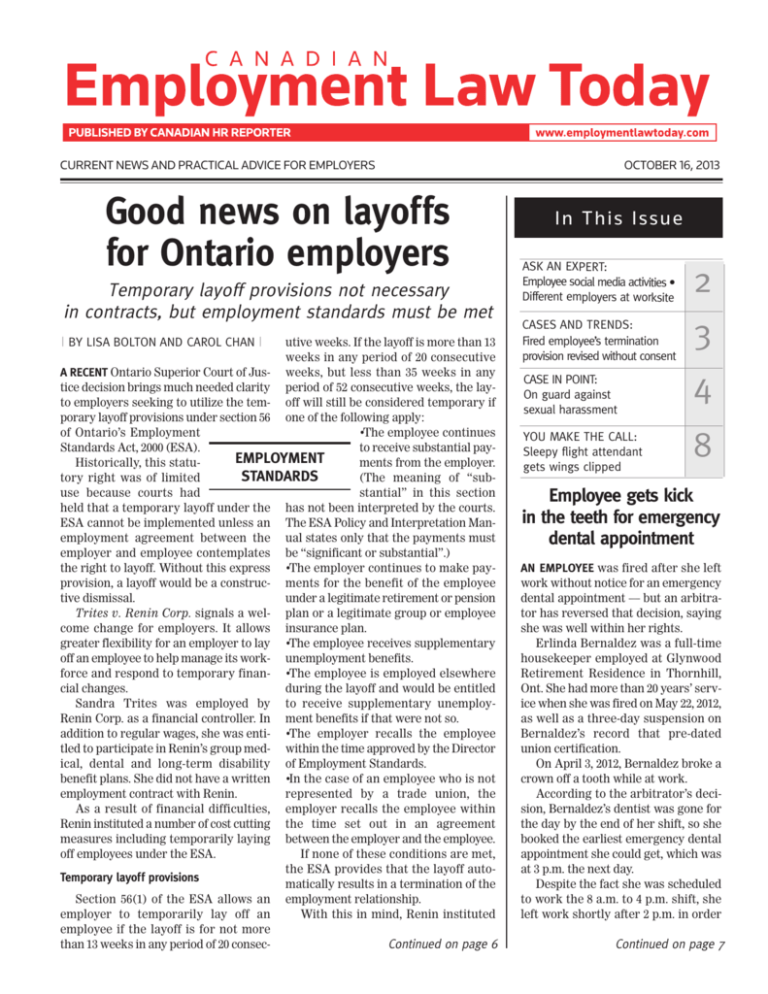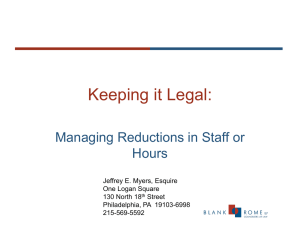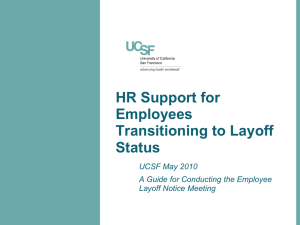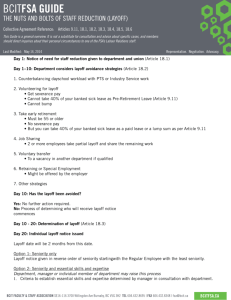Good news on layoffs for Ontario employers
advertisement

CURRENT NEWS AND PRACTICAL ADVICE FOR EMPLOYERS Good news on layoffs for Ontario employers Temporary layoff provisions not necessary in contracts, but employment standards must be met | BY LISA BOLTON AND CAROL CHAN | utive weeks. If the layoff is more than 13 weeks in any period of 20 consecutive A RECENT Ontario Superior Court of Jus- weeks, but less than 35 weeks in any tice decision brings much needed clarity period of 52 consecutive weeks, the layto employers seeking to utilize the tem- off will still be considered temporary if porary layoff provisions under section 56 one of the following apply: of Ontario’s Employment •The employee continues Standards Act, 2000 (ESA). to receive substantial payEMPLOYMENT Historically, this statuments from the employer. STANDARDS tory right was of limited (The meaning of “subuse because courts had stantial” in this section held that a temporary layoff under the has not been interpreted by the courts. ESA cannot be implemented unless an The ESA Policy and Interpretation Manemployment agreement between the ual states only that the payments must employer and employee contemplates be “significant or substantial”.) the right to layoff. Without this express •The employer continues to make payprovision, a layoff would be a construc- ments for the benefit of the employee tive dismissal. under a legitimate retirement or pension Trites v. Renin Corp. signals a wel- plan or a legitimate group or employee come change for employers. It allows insurance plan. greater flexibility for an employer to lay •The employee receives supplementary off an employee to help manage its work- unemployment benefits. force and respond to temporary finan- •The employee is employed elsewhere cial changes. during the layoff and would be entitled Sandra Trites was employed by to receive supplementary unemployRenin Corp. as a financial controller. In ment benefits if that were not so. addition to regular wages, she was enti- •The employer recalls the employee tled to participate in Renin’s group med- within the time approved by the Director ical, dental and long-term disability of Employment Standards. benefit plans. She did not have a written •In the case of an employee who is not employment contract with Renin. represented by a trade union, the As a result of financial difficulties, employer recalls the employee within Renin instituted a number of cost cutting the time set out in an agreement measures including temporarily laying between the employer and the employee. off employees under the ESA. If none of these conditions are met, the ESA provides that the layoff autoTemporary layoff provisions matically results in a termination of the Section 56(1) of the ESA allows an employment relationship. employer to temporarily lay off an With this in mind, Renin instituted employee if the layoff is for not more than 13 weeks in any period of 20 consecContinued on page 6 OCTOBER 16, 2013 In This Issue ASK AN EXPERT: Employee social media activities • Different employers at worksite CASES AND TRENDS: Fired employee’s termination provision revised without consent 2 3 CASE IN POINT: On guard against sexual harassment 4 YOU MAKE THE CALL: Sleepy flight attendant gets wings clipped 8 Employee gets kick in the teeth for emergency dental appointment AN EMPLOYEE was fired after she left work without notice for an emergency dental appointment — but an arbitrator has reversed that decision, saying she was well within her rights. Erlinda Bernaldez was a full-time housekeeper employed at Glynwood Retirement Residence in Thornhill, Ont. She had more than 20 years’ service when she was fired on May 22, 2012, as well as a three-day suspension on Bernaldez’s record that pre-dated union certification. On April 3, 2012, Bernaldez broke a crown off a tooth while at work. According to the arbitrator’s decision, Bernaldez’s dentist was gone for the day by the end of her shift, so she booked the earliest emergency dental appointment she could get, which was at 3 p.m. the next day. Despite the fact she was scheduled to work the 8 a.m. to 4 p.m. shift, she left work shortly after 2 p.m. in order Continued on page 7 October 16, 2013 ESA allowed for temporary layoffs regardless of contract ...continued from page 1 rolling layoffs. By tracking the timing of each layoff, Renin sought to avoid a deemed termination by recalling employees within the statutory time limits. Layoff was constructive dismissal: Employee Trites was laid off in November 2011. When she was advised in January 2012 that she would not be recalled until July 2012, she found new employment and sued Renin for constructive dismissal. In support of her claim, Trites relied on Martellacci v. CFC/INX for the proposition that a temporary layoff under the ESA cannot be affected unless the employment agreement contemplates the right to layoff. In this case, as there was no written contract governing her employment, Trites asserted Renin had no right to unilaterally lay her off. The court rejected Trites’ argument, finding the temporary layoff provisions in the ESA applied regardless whether there was an express or implied contractual right to lay off an employee, provided the employer complied with the statutory requirements for a temporary layoff under the ESA. In this case, however, the court found Renin’s layoff did not comply with the requirements in the ESA because, during the layoff, Trites neither continued to receive substantial payments or supplementary unemployment benefits, nor did Renin continue to provide ongoing entitlement to medical or dental benefits. As a result, the court found Trites had been constructively dismissed from her employment. Lessons for employers This decision is good news for employers, but with a caveat. On the one hand, the decision opens up new opportunities to implement temporary layoffs to respond to financial hardship. On the other hand, employers must continue to ensure the layoff is made in compliance with the ESA. To minimize the risk of a constructive dismissal resulting from a temporary layoff, employers should consider the following best practice suggestions: •Expressly provide for layoffs in employment contracts and employee policies because, although Trites v. Renin signals a new direction in the law, it is much easier and safer to include this as a term of employment from the start of the employment relationship. •Ensure the time restrictions for a temporary layoff set out in the ESA are met. •Ensure the ESA’s criteria for a 35-week temporary layoff are met by: •providing employees substantial payments, benefits, or supplementary unemployment benefits during the lay- off period •notifying employees of payments or benefits to be made during the layoff •recalling employees within the time period set out in the ESA or any applicable collective agreement. CELT For more information see: v. Renin Corp., 2013 CarswellOnt 5634 (Ont. S.C.J.). ■Martellacci v. CFC/INX, 1997 CarswellOnt 885 (Ont. Gen. Div.). ■Trites ABOUT THE AUTHORS Lisa Bolton Carol Chan Lisa Bolton and Carol Chan are lawyers with Sherrard Kuzz LLP, a management-side employment and labour law firm in Toronto. Lisa and Carol can be reached at (416) 603-0700 (Main), (416) 420-0738 (24 hour), or by visiting www.sherrardkuzz.com. Employee induced minority owner to sign: Employer ...continued from page 3 Bychowski didn’t have a signed employment contract with the severance provision they were enforcing, since Lovely had rejected it when it was presented to him. In fact, they admitted they were “embarrassed” to discover they didn’t. The court determined Lovely never agreed to the new termination provision, either orally or in writing, and therefore it was “unlawful and unenforceable.” In addition, the lack of any notice of severance for what was essentially a two-year term of employment was contrary to 6 employment standards minimums, which made the provision in the termination letter void, said the court. The court also found Lovely had proceeded as if he believed the original contract he drafted was in effect – calling himself president of Prestige, among other things – and none of the company’s ownership did anything to contest it, which would have been expected had they believed the other contract was in effect. The company also tried to argue Lovely had induced the minority owner to sign his original contract and job description by saying it was only for his work permit, but the court didn’t find this likely, as Lovely’s representations were true – he intended it to be the employment contract and he needed it to secure work permit approval. The court found the March 20, 2008, contract was in effect and McDonald & Bychowski were “obliged to discharge the promise they made” in that contract. This involved paying Lovely one year’s base salary upon termination – the year remaining on the contract – totaling $76,425. See Lovely v. Prestige Travel Ltd., 2013 CarswellAlta 1575 (Alta. Q.B.). Published by Canadian HR Reporter, a Thomson Reuters business 2013 CELT




